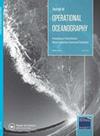应用区域锁定、浅水Argo浮标在波罗的海监测
IF 2.4
3区 地球科学
Q4 METEOROLOGY & ATMOSPHERIC SCIENCES
引用次数: 12
摘要
Argo浮标已经在世界海洋中成功使用了十多年。2011年,芬兰气象研究所开始开发在波罗的海淡咸水浅水中使用Argo浮标的实践。自2012年以来,Argo浮标一直在波罗的海持续使用,现在是Euro-Argo欧洲研究基础设施联盟(ERIC)的一部分。漂浮物被保存在波罗的海的不同盆地中,通常保存一年,然后回收并更换一个新的漂浮物。在监测模式下,观察周期通常为一周,但我们也使用较短的间隔,最长可达一天。在适当的驾驶实践下,Argo浮标在监测和研究浅海边缘海域方面具有很大的价值,因为它们全年都能提供定期和频繁的数据,而不管天气状况如何。浮筒的操作已经成熟到我们可以声明对波罗的海的阿尔戈监测是一种可行的现实的程度。本文章由计算机程序翻译,如有差异,请以英文原文为准。
Applying area-locked, shallow water Argo floats in Baltic Sea monitoring
ABSTRACT Argo floats have been successfully used for more than 10 years in the world's ocean. The Finnish Meteorological Institute began to develop practices to use Argo floats in the shallow brackish water Baltic Sea in 2011. Since 2012, Argo floats have been in continuous use in the Baltic Sea and are now a part of the Euro–Argo European Research Infrastructure Consortium (ERIC). The floats are kept in the different basins of the Baltic Sea, usually for a year and then recovered and replaced with a new float. The observation cycle is usually a week in monitoring mode, but we have also used shorter intervals up to one day. With proper piloting practices, Argo floats are of great value in monitoring and for research of shallow marginal seas, as they give regular and frequent data around the year, regardless of weather conditions. Operating the floats has matured to a level where we can state that Argo monitoring of the Baltic Sea is an operative reality.
求助全文
通过发布文献求助,成功后即可免费获取论文全文。
去求助
来源期刊
CiteScore
7.50
自引率
9.70%
发文量
8
审稿时长
>12 weeks
期刊介绍:
The Journal of Operational Oceanography will publish papers which examine the role of oceanography in contributing to the fields of: Numerical Weather Prediction; Development of Climatologies; Implications of Ocean Change; Ocean and Climate Forecasting; Ocean Observing Technologies; Eutrophication; Climate Assessment; Shoreline Change; Marine and Sea State Prediction; Model Development and Validation; Coastal Flooding; Reducing Public Health Risks; Short-Range Ocean Forecasting; Forces on Structures; Ocean Policy; Protecting and Restoring Ecosystem health; Controlling and Mitigating Natural Hazards; Safe and Efficient Marine Operations

 求助内容:
求助内容: 应助结果提醒方式:
应助结果提醒方式:


